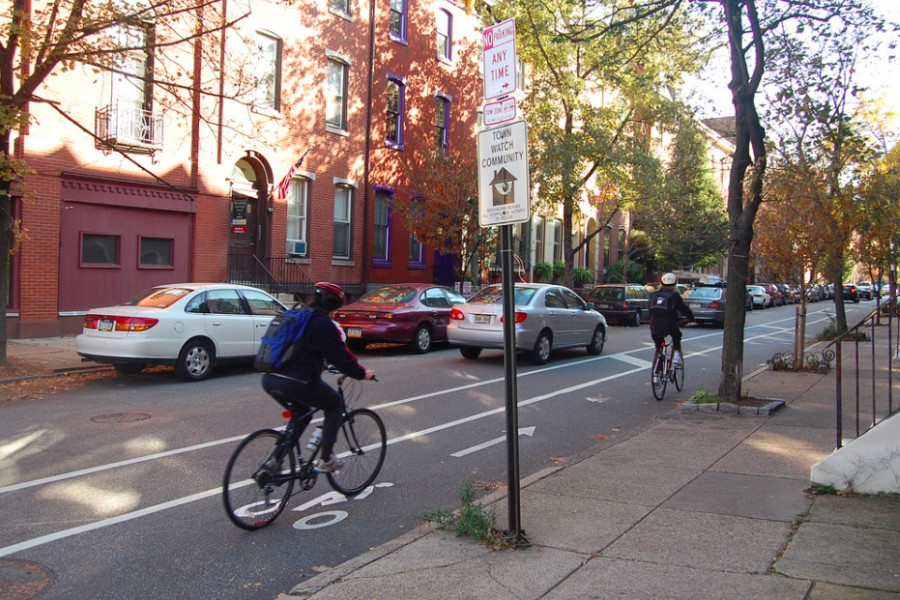Despite Cyclist’s Death, City Won’t Promise Protected Lane on Spruce
Here's what officials had to say about upgrading the bike lane where Emily Fredricks was struck and killed by a garbage truck this week.

Image via the Bicycle Coalition of Greater Philadelphia
Emily Fredricks, a 24-year-old cyclist, pastry chef, and artist, was struck and killed by a trash truck during her morning commute on Tuesday. She was riding her bike west on Spruce Street – using the bike lane, as she told her parents she would – when the large vehicle traveling beside her turned right into her path and killed her.
In the wake of her death, bike advocates have a clear message for Philly: The tragedy was preventable, and the city must take immediate action to ensure it doesn’t happen again.
Groups like the Bicycle Coalition of Greater Philadelphia argue that the existing bike lanes on Spruce and Pine streets – the busiest in the city – need more protection than the new paint job that the city promised next month. The roads need some kind of additional barrier between bikers and cars, cyclists say. Something to prevent vehicles from swerving into or blocking bikers. Something to make drivers more aware of the imperative need to share the street.
Cyclists are imploring everyone affected to amplify their demands to city officials, like Councilman Mark Squilla and Councilman Kenyatta Johnson, who oversee districts that include Spruce and Pine streets, as well as the Office of Transportation and Infrastructure Systems, which is responsible for implementing protected bike lanes.
At this point, OTIS has not moved beyond discussing the possibility of protected bike lanes of Spruce and Pine streets, which it first unofficially proposed more than a year ago. On Thursday afternoon, OTIS officials said they have yet to create a design or official proposal for protected bike lanes along the streets, and they did not guarantee that they would ever do so.
Some background: The city currently has 2.5 miles of protected bike lanes. Mayor Jim Kenney promised to increase that number to 30 by 2022, meaning the city would need to install 28 miles of protected bike lanes in five years. To help make this possible, Philly has received two safety infrastructure grants totaling $550,000. According to Philly.com, that’s enough money to fund roughly 25 miles of protected bike lanes. Surely the busiest bike lanes in the city would make a good starting point for this goal.
But Mike Carroll, the deputy managing director of OTIS, said the organization has only “looked at doing some protective infrastructure” along the Spruce and Pine streets, and that it is “still trying to sort out the feedback and figure out whether there’s a path forward.”
Carroll said he and others don’t want to adopt a “narrow focus on a specific street or a specific block.” Instead, he said, OTIS is focusing on “the larger network” of bike lanes in the city, in conjunction with projects like Vision Zero, which aims to eliminate traffic-related fatalities by 2030. In the foreseeable future, OTIS plans to establish protected bike lanes along South Street (between 22nd and 27th streets) as well as along Spring Garden Street (from river to river), said OTIS’s Kelley Yemen.
Carroll said the widths of Spruce and Pine streets would make it extremely difficult to implement parking-protected bike lanes (like the one installed on Chestnut Street earlier this year), which he called “a gold standard for protected bike lanes” in Philly. At this time, Carroll said, the organization believes plastic flexible delineator posts could be a potential solution for the two roads.
Inaction is unacceptable: 7 demands we've made to the City of Philadelphia for better streets and safer bike lanes. https://t.co/2tsk9wBMHl pic.twitter.com/EelwKb1C7m
— Bicycle Coalition of Greater Philadelphia (@bcgp) December 1, 2017
To the frustration of many bike safety advocates, the Washington Square West Civic Association has not taken a position on protected bike lanes along Spruce and Pine. Earlier this year, a board member told the Inquirer that protected bike lanes could interfere with a “gentlemen’s agreement that cars would be permitted to pull over for deliveries. … Contractors park in front of houses, and the bike lane has the potential to disrupt that.”
On Thursday, WSWCA’s president, Rick Spitzborg, said the organization “supports bicyclists’ safety” but remains undecided on the matter. Spitzborg said the group is waiting for OTIS to present a plan before members will declare a position on the bike lanes.
“We would like our community to understand what the options are,” he said.
Both OTIS and WSWCA have been in discussion with councilmen Squilla and Johnson, whose districts include Spruce and Pine Street east and west of Broad Street, respectively.
Both councilmen said on Thursday that they support bicyclists’ safety and have been in ongoing communication with OTIS in regard to protected bike lanes along the roads. They also have co-sponsored a resolution that Councilwoman Blondell Reynolds Brown put forth this week, which calls for regular hearings on the status of Vision Zero.
Philly has seen 77 traffic-related fatalities so far this year, including three bicyclists. Squilla said the city “needs to do a better job making sure it’s safe on our roads and sidewalks.”
In a statement, Johnson said he expects “to see significant progress towards a safer streetscape in the Second Council District” in the coming months.


